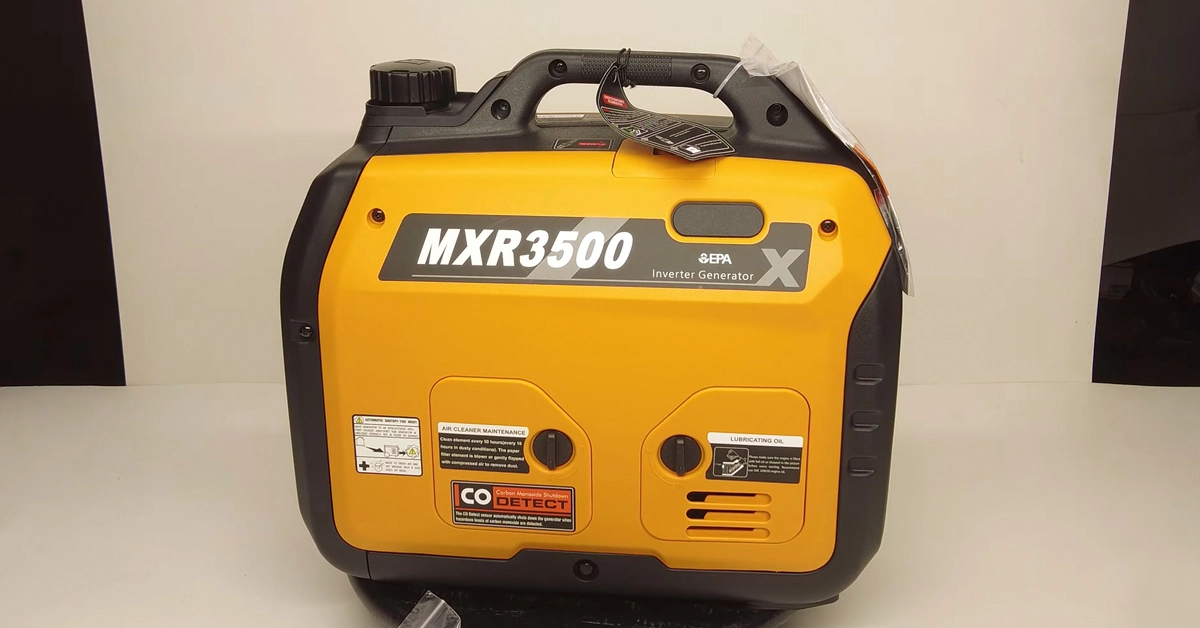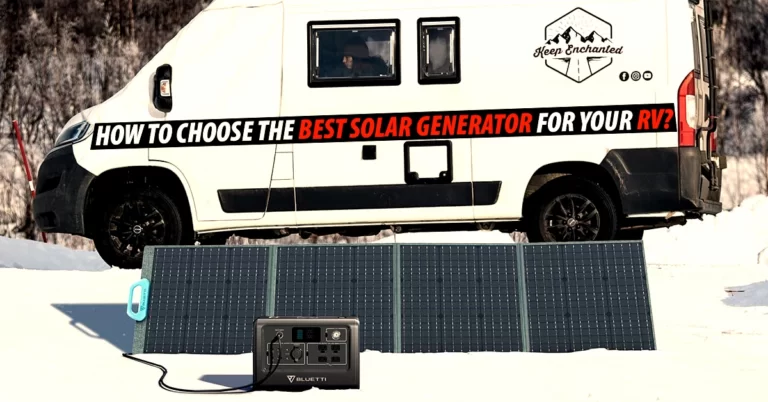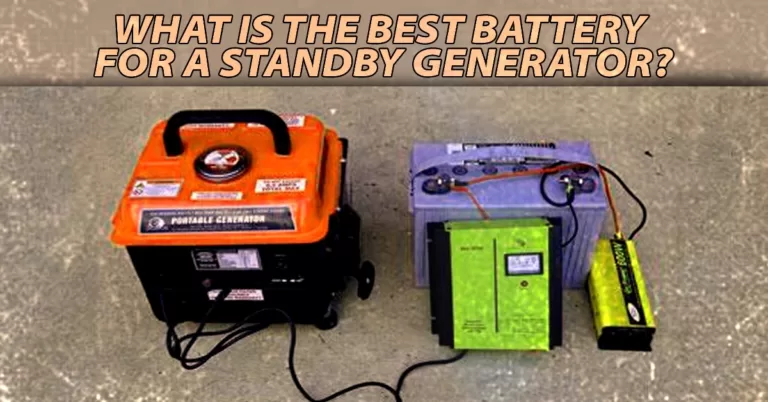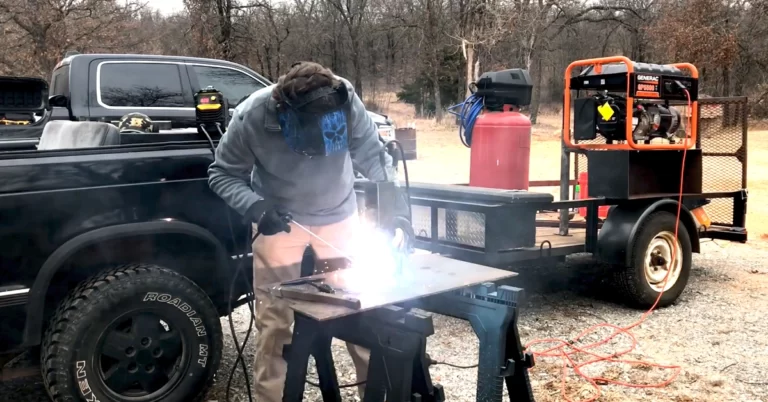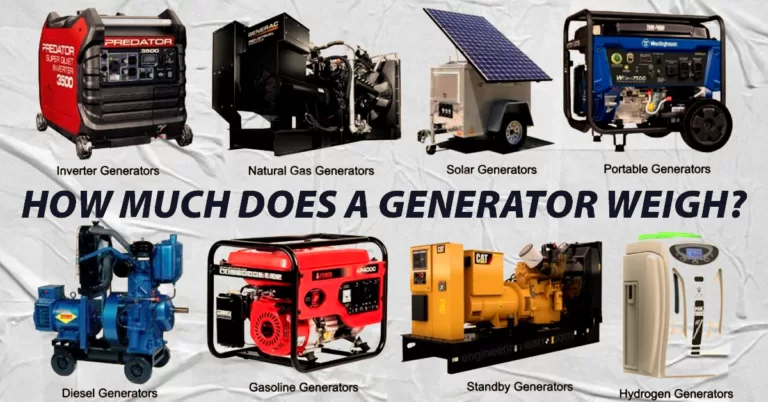What Appliances Will A 3500 Watt Generator Run?
When you need a reliable backup power source and have a 3500-watt generator, you might ask, “What Appliances Will A 3500 Watt Generator Run?” and “Where can I use it?” To make the right choice, consider the type of generator you need, such as conventional, inverter, or dual fuel. Also, decide whether to use gasoline or propane, depending on what’s available and what you prefer.
Next, figure out the combined wattage required for your appliances. The generator can handle lights, fans, laptops, and charging devices, but more is needed for power-hungry equipment like central ACs or big compressors.
This approach lets you make a well-informed decision and get a power source that fits your needs. I cover all these points in this post for you, so keep reading to find the perfect match for your power backup needs.
What Can a 3500 Watt Generator Run?
Generally speaking, a 3500-watt generator of this kind can power practically all home appliances, power tools, and RV and camping equipment, including:
| Appliance/Device | Power Consumption (Watts) |
|---|---|
| A couple of power tools | 800 |
| Bench grinder | 1,400 |
| Ceiling fan | 60 |
| Coffee maker | 1,000 |
| Dishwasher | 1,500 |
| Espresso machine | 1,300 |
| Fridge with a freezer | 700 |
| Hammer drill | 1,000 |
| Laptop | 50 |
| Medium radiant heater | 1,800 |
| Microwave oven | 1,000 |
| Pressure cooker | 700 |
| Radial arm saw | 2,000 |
| Small heating system | 500 |
| Small well pump (1/2 HP) | 1,000 |
| Small window AC unit | 1,200 |
| Smaller electric appliances | 400 |
| Steam iron | 2,200 |
| Sump pump (1/2 HP) | 1,050 |
| Toaster | 850 |
| TV | 85 |
| Vacuum cleaner | 200 |
| VCR / DVD Player | 100 |
| Washing machine | 1,150 |
Read Also: What Will A 7500 Watt Generator Power?
What Appliances Can A 3500-Watt Generator Run?
Are you understanding What Appliances Will A 3500 Watt Generator Run? It can handle gives you the ability to prepare for power outages, operate efficiently without dedicated lines on job sites, comfortably travel in RVs, and improve your tailgating. Together, let’s investigate!
Power Outage at Home
Prioritizing Your Essentials: During a power outage at home, you become the manager of critical appliances – refrigerators, freezers, and lights – to preserve freshness and ensure safety and convenience.
Daily Routines Uninterrupted: Embrace the convenience of powering microwaves, electric stoves, laptops, and smartphones even when the lights go out.
Handling Power-Hungry Appliances: Juggling power usage for air conditioning units and pumps during emergencies becomes your skillful game.
Work Sites
Powering Your Projects: Just like contractors, you become the master of your projects, relying on your 3500-watt generator to handle circular saws, air compressors, drills, and nail guns.
Multi-User Management: Learn the art of power distribution when multiple hands wield different tools.
RV Trips
Journey in Comfort: Ensure a smooth RV trip as you power essential appliances like air conditioners, refrigerators, lights, and entertainment systems on the go.
Balance for Efficiency: Plan smartly to enjoy a convenient trip without pushing your generator beyond its limits.
Tailgating Events
Fueling the Fun: Unleash the power of your generator to enhance tailgating with appliances like televisions, laptops, and lights, adding flair to the event.
Extra Fun with Additions: Add a minifridge or electric grill for convenience and excitement.
What Appliances Will A 3500 Watt Generator Run? Reliable Backup
- Kitchen Appliances: Discover the magic of keeping your kitchen functional during power outages with your generator by your side.
- Living-Room Appliances: Elevate your living room entertainment and connectivity with uninterrupted power for televisions, TV, laptops, Xbox gaming consoles, and more.
- Office Appliances: Maintain productivity during power disruptions in your small office setup with the support of your trusty generator.
- High Starting Power Appliances: Master the art of managing appliances with high starting power requirements, like washing machines, sewing machines, and dishwashers.
How to Choose a 3,500-Watt Generator
The first thing you should determine when considering a 3,500-watt generator is what kind of generator would work best for you. What appliances can a 3,500-watt generator run?
Types of Generators: Portable vs. Standby
Portable Generators
If you want a generator that you can quickly move around and take with you on outdoor adventures or use for short-term power needs, a portable generator is the way to go. They are versatile and can be a great companion for camping trips or when you need power in different places.
Standby Generators
On the other hand, if you want a permanently installed generator that automatically turns on during power outages, a standby generator is the right choice. It provides continuous power for an extended period, which is perfect for those who experience frequent or long-lasting power outages.
Types of Fuel: Gasoline, Diesel, Propane
When it comes to fuel options, you have a few choices, and it’s essential to pick one that suits your needs:
Gasoline Generators
A gasoline generator might be for you if you prefer something familiar and easy to find. Gasoline is readily available in most places, so refueling is convenient. Remember that gasoline may not store well for a long time, and you might need stabilizers.
Diesel Generators
Consider a diesel generator if you want a fuel-efficient option that’s better for long-term storage. It’s a good choice for backup power during extended outages, ensuring you have electricity when needed most.
Propane Generators
For those concerned about the environment, a propane generator is a cleaner-burning option that emits fewer emissions. Propane is readily available, and it stores well compared to gasoline. If you want a more eco-friendly choice, this could be right for you.
Understanding Generator Wattage
Understanding the power requirements of the appliances and equipment you wish to power during an outage or in an off-grid situation will help you choose the ideal generator size for your needs.
Make a List of Appliances
First, list all the electronic appliances you want to keep running when the electricity goes out or during off-grid situations.
Identify Running Watts and Starting Watts
For each appliance, figure out how much continuous power it needs to keep running (running watts) and how much energy it requires to start (starting watts). This information is often found on the appliance’s data tag or user manual.
Determine the Overall Wattage Requirement
The operating watts of all the appliances you intend to use at once are added. You may calculate how many watts you require using this total continuous power.
Account for Starting Watts
Identify the appliance with the highest starting watts among your selection. Add this value to the total continuous power to find the total starting wattage required for the generator.
Importance of Surge Watts and Continuous Watts
- Running Watts The term “running watts” describes the steady power output the generator can produce over time. It is the consistent energy required to keep your electronics and appliances functioning once turned on.
- Starting Watts On the other hand, starting watts are the maximum power output needed to create some appliances, especially those with motors. Some appliances use more energy to start up than to maintain operation.
How To Determine The Wattage Of Your Appliance: Example Calculation
To make things more transparent, here’s an example of how to calculate your power requirements:
| Appliance | Running Watts | Starting Watts |
| Toaster | 850 | 0 |
| Refrigerator/Freezer | 700 | 2,200 |
| Laptop | 50 | 0 |
| Lamp (2 Lightbulbs) | 150 | 0 |
| Window AC (10,000 BTU) | 1,200 | 3,600 |
Total Running Watts: 850 + 700 + 50 + 150 + 1,200 = 2,950 watts Total Starting Watts: 2,950 + 3,600 = 6,550 watts
Not all electrical appliances have running watts listed on their data tags, so keep that in mind. The following equation can be used to calculate the running watts:
Watts (W) = Volts (V) x Amps (A).
It is comparable to Ohm’s law from high school physics. You may easily determine the estimated running watts for your appliances using the necessary Volts and Amps.
In this example, a 3,500-watt generator may not be enough to power all the listed appliances simultaneously because of the higher starting watts required by the refrigerator and the window AC unit. If you expect to run multiple high-power devices together, consider getting a higher surge wattage capacity generator to handle the initial power demands.

Can a 3,500-Watt Generator Power an RV AC Unit?
Generally, a 3,500 – 4,000 running watts generator should work for a small RV AC unit (11000 BTU) without problems. But it depends on the AC’s exact power needs.
Here are some estimates for different RV AC units:
- 11000 BTU needs about 1,050 running watts and 1,600 starting watts.
- 13000 BTU requires around 1,800 running watts and 2,800 starting watts.
- 15000 BTU uses approximately 2,000 running watts and 3,300 starting watts.
The starting watts are essential. To know for sure, check your RV AC’s info plate for voltage and amperage details.
Use this equation: Watts (W or kW) = Volts (V) x Amps (A) to find the correct wattage.
Knowing the exact power needs will help your 3,500-watt generator handle your RV AC well and keep you comfortable during your trip.
Can a Window Air Conditioner Be Powered On a 3,500 Watt Generator?
You can use a 3,500 Watt portable generator to run a window air conditioner efficiently. Most window ACs come in sizes from 5,000 to 12,000 BTU, with 12,000 BTU being quite common. For a 12,000 BTU window AC, you’ll need around 1,200 running Watts and 2,400 starting Watts. A 3,500W generator usually provides over 4,000 starting Watts, so you’ll have more than enough power to run your window AC without any problems. It works well when I use my 3,500W generator to power my 12,000 BTU window AC.
Can a 13,500 BTU Air Conditioner Be Run On A 3,500 Watt Generator?
You can run a 13,500 BTU air conditioner with a 3,500 Watt generator. If I have an average 13,500 BTU air conditioner, it requires around 1,250 running Watts and 2,750 starting Watts. So, if you’re running the air conditioner alone, with no other appliances plugged in, your 3,500W generator will easily power the AC without any problems.
Why Are There Things You Cannot Run on A 3500-Watt Generator?
You should be aware of the limitations of your 3500-watt generator. There are some appliances that I cannot run on it because they draw too much power. If I try to power large devices that exceed the generator’s capacity, I risk overloading it and causing damage to its engine and electrical components. So, I must be mindful and avoid continuously running high-wattage devices to ensure safe and efficient operation. You must know the capabilities of your 3500-watt generator and understand that while it has its strengths, there are certain things you must avoid running to protect it from harm.
Can a 3500-Watt Generator Power Everything at Once?
Using a 3500-watt generator, you can’t run everything in your whole house simultaneously. You must be careful and use one thing at a time, like the kettle, microwave, and induction stove. Before using the other, make sure to turn the first one off.
Your power usage decreases after you finish cooking, cleaning, or working. Most people only need some of the power the generator provides. When you’re not using the refrigerator, heating, or kettle, the total energy required can go below 3500 watts.
Because of this, it’s wise to take as little action as possible when the power goes out. By doing so, you may conserve energy and fuel while also relaxing. The power usually comes back after a few hours when folks like you require generators. Rarely, it could require a few days.
What Amp Capacity Can a 3,500 Watt Generator Produce?
A 3,500-watt generator provides around 29.2 amps at 120 or 14.6 amps at 240 volts. To find the amps, divide the wattage by the voltage (Amps (A) = Watts (W) / Volts (V)). Here’s a cheat sheet for some power requirements of household appliances:
| Watts | 120 V | 240 V |
|---|---|---|
| 500 | 4.2 A | 2.1 A |
| 1000 | 8.3 A | 4.2 A |
| 2000 | 16.7 A | 8.3 A |
| 3000 | 25.0 A | 12.5 A |
| 4000 | 33.3 A | 16.7 A |
| 5000 | 41.7 A | 20.8 A |
| 6000 | 50.0 A | 25.0 A |
| 7000 | 58.3 A | 29.2 A |
| 8000 | 66.7 A | 33.3 A |
| 9000 | 75.0 A | 37.5 A |
| 10000 | 83.3 A | 41.7 A |
| 12000 | 100.0 A | 50.0 A |
| 14000 | 116.7 A | 58.3 A |
| 16000 | 133.3 A | 66.7 A |
What Is The Gas Consumption of A 3500 Watt Generator?
If you have a 3,500-watt generator, you may wonder how much gas it uses. The gas consumption of a 3,500-watt generator can vary depending on its load. It may use between 0.6 to 1.2 gallons of gas per hour. For example, when I run it at half capacity, it might use around 0.6 gallons of gas per hour, and when I push it to its maximum capacity, it can consume approximately 1.2 gallons per hour. However, remember that these are approximate values, and it’s always best to check your generator’s manual or the manufacturer’s specifications for more precise information.
Let me give you an additional example: the Westinghouse iGen4500 4,500W generator. It’s known for being fuel-efficient, using about 0.55 gallons of gas per hour when I run it at a 50% load. This makes it an excellent choice for more prolonged usage while managing fuel consumption effectively.
When using a 3,500W generator, you can power many household items at the same time, like a refrigerator (700W), your laptop (50W), and a few lightbulbs (150W). However, keep the generator manageable by running high-wattage appliances together, such as air conditioning units (1,200W running, 3,600W starting). Always add up the wattages of the devices you want to use to ensure the generator can handle it safely and efficiently.
Will a 3,500-watt generator power a well pump?
If you have a 3,500 – 4,000 running watts generator, it should handle a small well pump, but knowing the exact wattage is crucial. Here are estimates for different pump types:
Generator Wattage Requirements for Different Pump Horsepower
| Pump Horsepower | Running Watts | Starting Watts | Generator Compatibility |
|---|---|---|---|
| 1/3 HP | 750 | 1,500 | Check your pump’s wattage for certainty. |
| 1/2 HP | 1,000 | 2,100 | Your 3,500-watt generator should handle it well. |
| 3/4 HP | 1,500 | 3,000 | Check if your 3,500-watt generator can manage it. |
| 1 HP | 2,000 | 4,000 | It might be challenging for your generator. |
| 1 & 1/2 HP | 2,500 | 5,000 | Running it on a 3,500-watt generator might be risky. |
Keep in mind starting watts matter more than running watts. Check the info-plate for voltage, amperage, and horsepower, then use this equation to find the required wattage:
Watts (W or kW) = Volts (V) x Amps (A)
Can a 3500 Watt Generator Operate an Air Compressor?
In most cases, a generator with an operating wattage of 3,500–4,000 should be able to operate a small air compressor without any problems. However, knowing the precise running and starting watts needed by your particular air compressor is necessary to provide an apparent response to this query.
I have found rough estimates for different types of compressors:
- 1/2 Horse Power – It takes 975 running watts and 1,600 starting watts.
- 1 Horse Power – It takes 1,600 running watts and 4,500 starting watts.
The difficulty is with the starting watts rather than the running watts, as you can see from the calculations above. You must locate the voltage, amperage, and horsepower information on your compressor’s info plate to obtain exact figures.
Then, all you have to do to figure out the needed wattage is use this equation:
Watts (W or kW) = Volts (V) x Amps (A)
You can ensure that your 3,500-watt generator is capable of handling the job and prepared to efficiently power your tools by understanding the exact power requirements of your air compressor.
Inverter vs. Conventional 3,500-Watt Generators
In today’s world, reliable power generation is essential for various applications, from powering our homes to providing electricity at construction sites. With advancements in generator technology, you now have two distinct designs to choose from:
- Inverter generators
- Conventional generators
In this comparison, I will explore the differences between these two types of generators, mainly focusing on their suitability for 3,500-watt power needs.
Inverter vs. Conventional: Benefits
Compared to their conventional substitutes, inverter generators stand out thanks to several benefits.
- One of the most significant advantages is that they can power not just your typical home appliances and power equipment but also delicate devices like smartphones, computers, and televisions.
- An inverter generator is a smart choice if you’re going on an outdoor excursion in your RV and need to power your fridge and microwave and charge your devices.
- Connecting two units in parallel is another benefit of inverter generators. As a result, if you purchase two 3,500-watt inverter generators, you can link them and use one of them to generate up to 7,000 watts.
- This can be tremendously helpful when you need more power, such as during a power outage or when operating many large appliances simultaneously.
Conventional and Inverter Generator Comparison
You will find two different generator designs when shopping: traditional and inverter. Conventional generators are more cost-effective because they are often less expensive. However, it could be more challenging to get your appliances up to maximum power or to start them while they’re under stress. It could be annoying when you need your generator to function well in an emergency.
The voltage output of traditional and inverter generators is one of their primary differences. Conventional generators create a “Square Wave” voltage that fluctuates gradually rather than continuously. Managing this kind of electricity could be difficult for many items, especially electronics prone to damage, like computers. Inverter generators, on the other hand, produce a “Modified Sine Wave” voltage that smoothly switches between the + and – connections of the inverter. Thanks to this approach, which simulates the electrical supply from the power source, inverter generators are more suited to handle fragile electronics.
Suitability and Use Cases:
Considering the higher price of inverter generators, they are recommended for specific applications. They work well at building sites and places where precisely regulated electricity is needed. However, inverter generators may not be the best choice for most residential consumers due to their cost. A conventional generator might be more cost-effective if you’re a homeowner looking for one to cover basic power needs during emergencies.
Additionally, the rising energy efficiency of appliances must be taken into account. In other situations, you might not even need a generator because so many contemporary models are built to require less electricity. Check the wattage of every appliance in your home to determine if anything exceeds 1,500 watts. If so, think about getting a generator to satisfy your power needs.
The decision between an inverter and a standard 3,500 watt generator will ultimately depend on your unique requirements and financial constraints. The ability to power delicate electronics and provide alternatives for parallel connections makes inverter generators ideal for various applications. Their more excellent price may only be affordable for some people, though. Conventional generators are still cheaper, although they could need assistance with some appliances and devices.
FAQs
-
What Advantages Are There to Purchasing a 3500-watt Generator?
A 3500-watt generator has the following advantages:
-The majority of your devices and home appliances.
-It prevents you from worrying about being in the dark during a power outage by keeping your lights on.
-It keeps you linked by allowing you to charge your phones and other gadgets.
-It runs a portable air conditioner to keep you cool when sweltering outside.
-It enables you to prepare meals using kitchenware without using power from the grid. -
How Long Can a 3500-Watt Generator Run on a Tank of Gas?
If you have a 3500-watt generator, you’ll find that it can run for approximately 9 hours on a single gasoline tank. The actual runtime will depend on factors like the generator’s power, the size of the tank, and the type of gasoline you use. Using high-octane gasoline might reduce the runtime compared to using low-octane petrol. So, if I have a 3500-watt generator, I need to consider these factors to estimate how long it will run on a gas tank.
-
Can a 3500-Watt Generator Operate Around the Clock?
If you have a 3500-watt generator, you might wonder if it can run for 24 hours straight. Well, I wouldn’t recommend it. Running the generator continuously for over 12 hours can cause overheating, which might damage it. So, it’s best to give the generator some rest after extended use to cool down for about an hour before storing it. Taking care of your generator like this ensures its longevity and safe operation, just like I do with mine.
-
Can a 3,500 Watt Generator Power a Washing Machine?
Yes, you can use a 3,500-watt generator to run most washing machines. A regular washing machine needs about 400 to 1,400 watts per hour. The 3,500W generator can provide up to 2,800 watts when starting, which is more than enough for the washing machine.
Just remember to check your washing machine’s manual for its needed power. Usually, you can safely run one washing machine with a 3,500-watt portable generator if you don’t use other appliances that exceed its total capacity. -
Can a 3500 Watt Generator Power a Furnace or Heat Pump?
A heat pump or electric boiler may typically demand more electricity than a 3,500-watt operating generator. However, if you know the precise starting and running wattages your particular electric appliance requires, responding to this question becomes simpler. Therefore, it’s crucial to calculate the power requirements (watts) of the heat pump or furnace to determine whether the 3,500-watt generator can handle the load.
-
Can a 3,500-Watt Generator Power a Space Heater?
Yes, in most cases, a 3,500 – 4,000 running watts generator should be sufficient for a space heater. A rough estimate suggests a space heater requires around 1,800 running watts and 1,800 starting watts. For exact wattage specifications, look at the name tag on your appliance.
-
Will a 3,500 Watt Generator Run Two Refrigerators?
Yes, in most cases. A 3,500W generator can typically handle two refrigerators, as each fridge usually requires 600 to 1,200 starting watts. Just check the owner’s manual for specific requirements and consider other appliances connected to the generator.
-
Will a 3,500-watt Generator Run Central Air Conditioning?
We would like to know if a 3,500-watt generator can handle a central AC unit due to limited starting power. The power requirement depends on the specific AC model, so check the name tag for LRA, RLA, and FLA values. Consult the manufacturer or an electrician to determine if your generator can run the AC. Additionally, when connecting the generator, use a transfer switch to avoid appliance damage or endangering others working on electric lines.
-
What Type Of Oil Is Ideal For A 3,500 Watt Generator?
For a 3,500-watt gasoline generator with a 4-stroke engine, you should use SAE 30 in warmer climates or SAE 10W-30 in colder climates (check the owner’s manual). When selecting the oil, consider factors such as engine type, temperatures, fuel, oil certifications, and brand reputation.
-
How Long Will A 3,500-Watt Generator Run?
Each generator’s fuel usage and fuel tank capacity makes the problem only partially solvable. According to our observations, a typical 3,500-watt generator operates at 50% load for about 10.2 hours.
This figure is the median run time of about 13 generators that produce about 3,500 operating watts. -
Will A 3500 Watt Generator Run A 5000 BTU Air Conditioner?
Absolutely! Yes, you can use a 3,500 Watt generator to power a 5,000 BTU air conditioner. These AC units are small and only require around 500 Watts, so you should be fine running it with the 3,500 Watt generator if you’re wondering whether it will work perfectly!
-
Will a 3,500 Watt Generator be Used in Rv Trips?
A 3,500 Watt generator is suitable for RV travel. Many typical RV items, including air conditioners, microwaves, lights, and gadgets, can be operated with this amount of electricity. It is crucial to consider the power needs of your RV equipment. Additionally, when utilizing the generator while on an RV vacation, you should adhere to safety precautions and best practices.
End Words
For use at home, at business, on RV excursions, and at events, a 3500-watt generator provides a stable backup power source. During blackouts, it can effectively power necessary equipment and appliances. Be sure to consider your demands and budget while choosing between conventional and inverter kinds. Put essential appliances first for the best power distribution. Top performance is guaranteed when safety procedures are followed.
In conclusion, a 3500-watt generator offers comfort and security in times of need. What Appliances Will a 3500 Watt Generator Run? It is a flexible option for backup power requirements since it can handle a variety of home appliances and equipment.

